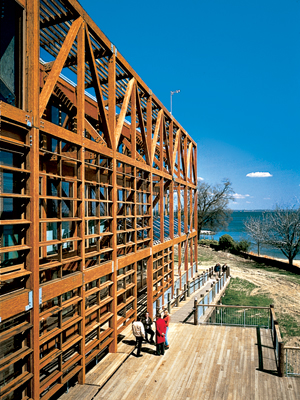At two recent architectural events — one academic, the other professional — sustainability met with both skepticism and criticism in ways I hadn’t anticipated. It suggests we have reached a point where sustainable architecture needs to be addressed more rigorously.

The academic event was a conference at the University of Michigan's Taubman College of Architecture and Urban Planning in April that focused on the place of history in architecture school curricula. Most explicit was Ellen Grimes, a professor in the School of the Art Institute of Chicago, for whom sustainability too often turns into the desire to return to a putatively “original” nature. She argued instead for an approach to the environment that is committed to the design of new ecological conditions.
To be sure, criticism of “sustainability” is not new. Michelle Addington, professor of sustainable architectural design at Yale, has become well-known for her deflation of architects' excessive environmental claims. But it was a first for me at Michigan to sense a generalized skepticism about “sustainability” on the part of younger architectural historians and theorists. Since the term was an almost universal mantra of the Association of Collegiate Schools of Architecture (ACSA) conferences I attended as a member of its board from 2006 to 2009, I found myself supposing that future ACSA events would be considerably stormier.
Just two months later, I attended a joint conference of the Architectural Institute of British Columbia and the Royal Architectural Institute of Canada in Vancouver. There, Dr. Raymond J. Cole of the Environmental Research Group at the University of British Columbia contributed to a session on “high-performance building envelope design.” Before Cole — a grand old man of sustainability in Canada — could conclude, he was criticized for encouraging architects to act in ways that could increase their risk of liability claims. His challenger was Chicago construction lawyer and principal of the Alberti Group, Ujjval Vyas, who was speaking the next day on “Going Green: A Cautionary Tale.”
Vyas, with his co-presenters, John Hackett, an architect in charge of risk management at Pro-Demnity Insurance Company, and Bernie McGarva, a Toronto construction lawyer with Aird and Berlis LLP, documented numerous claims made by both clients and third parties against architects in relation to the environmental performance of their designs. Some concerned allegations of technical failure of building components or assemblies that may have resulted from environmental-design ambition. It did not seem to me that they were so fundamentally different from technical liability claims already familiar to architects. A second set of allegations charged that buildings, once completed, failed to meet their designers' predictions of improved environmental performance, or of lowered operating costs. Finally, and most problematic of these, were allegations arising from public statements made by architects about environmental topics, unrelated to specific designs prepared for particular clients. Although Vyas did not give any specific examples, he insisted that architects needed to be careful about pronouncements on sustainability that relied on knowledge beyond their own professional expertise. Such statements could expose them to legal risk.
Vyas cited the Philip Merrill Environmental Center in Annapolis, Maryland, designed by SmithGroup (2000) which Cole had illustrated. It was the first American building to receive a LEED Platinum certification and has been called the greenest building in the world. It is now the subject of litigation between the Weyerhaeuser Company and the owner, architect, and contractor regarding the failure of certain “environmentally specified” structural members.
Needless to say, the issues raised in such discussions were not resolved there. Still, these experiences led me to conclude that we have reached the end of an initial phase of the development of sustainable architecture in North America. It is clear that we will need to redouble our future efforts in three important ways: first, to ensure successful fulfillment of technically based environmental ambitions for our buildings; second, to be more rigorous with regard to our predictions of performance — especially parameters of performance that are only partly within our own professional control.
Lastly, we need to find appropriate ways to defend our right — and our obligation — to act in our capacity as public intellectuals in this vitally important arena. Although our scientific expertise is limited, our generalist orientation to sustainability means that we architects remain uniquely positioned to articulate its manifold aspects in architecture and urbanism to the public at large.




Post a comment to this article
Report Abusive Comment